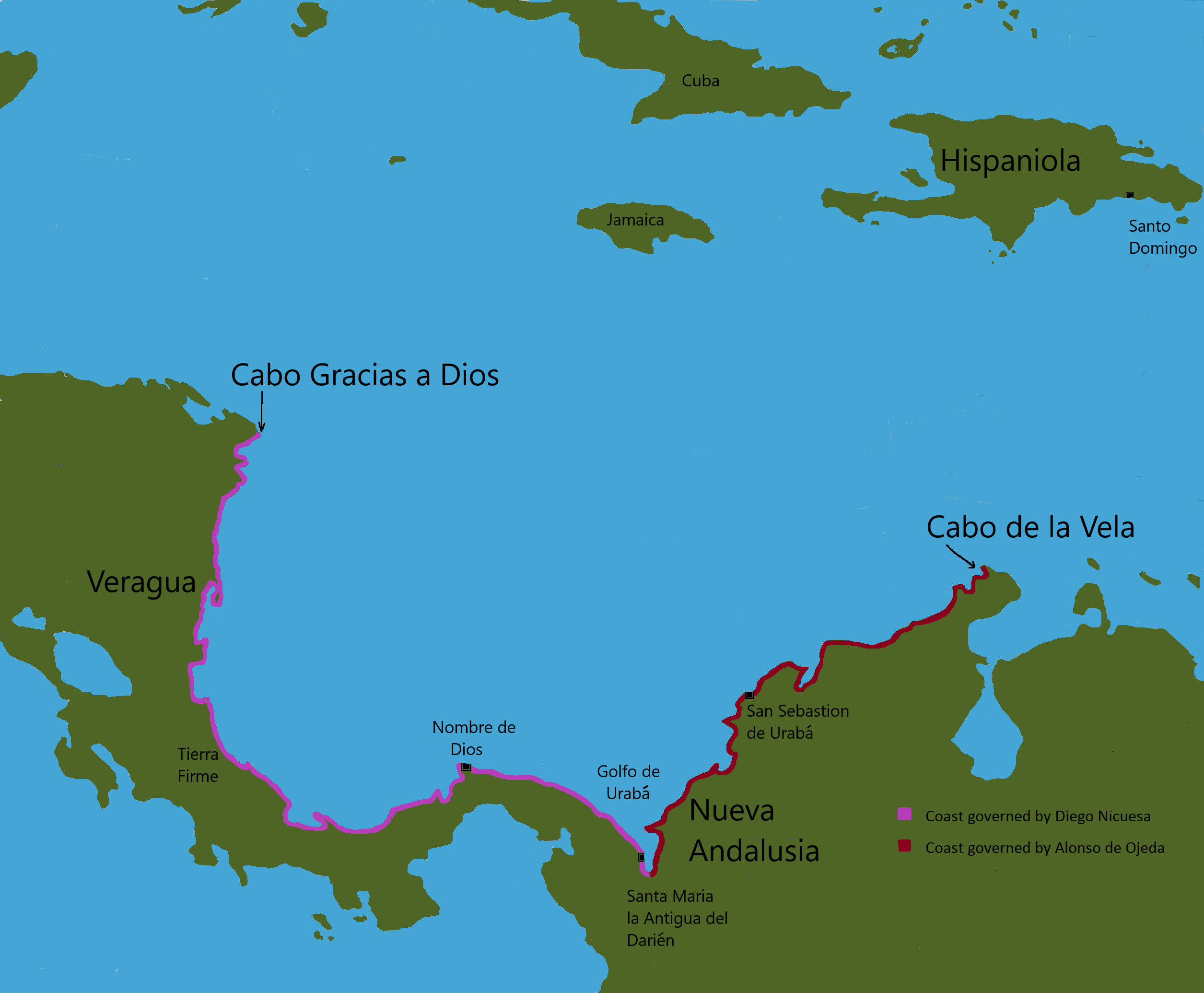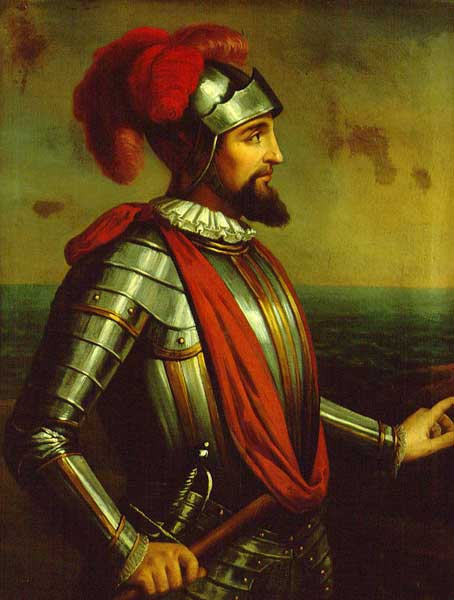This story begins in 1509 with the discovery of a stowaway and his dog hiding in a barrel that had been loaded onto a ship sailing from Santo Domingo in Hispaniola to San Sebastian in Nueva Andalusia in the Caribbean. The stowaway and his dog were brought before the commander of the ship, Martín Fernández de Enciso, who demanded their names. The 34 year-old stowaway gave his name as Vasco Núñez de Balboa and that his dog was named Leoncico. Further questioning revealed that both were running away from creditors in Santo Domingo.
Unimpressed with these two scoundrels, Enciso ordered that they be marooned on the first uninhabited Island that they passed. However, over the next couple of days the crew took a shine to Vasco and Leoncico and begged the commander to reconsider his harsh sentence. Furthermore, the prisoner had revealed that he had knowledge that may help him with his mission.
The King of Spain, Ferdinand II, began an initiative to explore and colonise the mainland known then as Tierra Firme. In 1508 he ordered the establishment of two provinces with their border in the Golfo de Urabá; Nueva Andalucía to the east governed by Alonso de Ojeda, and Veragua to the west governed by Diego de Nicuesa.

Enciso was Alcalde of Nueva Andalucía, and he was leading a rescue mission to go to the aid of a stranded group of settlers who had been surrounded by hostile natives. He had been sent by his superior officer, Alonso de Ojeda, who had founded the colony of San Sebastián de Urabá. Ojeda had landed with a force of 70 men to establish a fortified base on the new continent but had been forced to abandon them after being injured in the leg by a poisoned arrow. When he reached Hispaniola he immediately ordered a rescue mission carrying more armed men and much needed supplies. He left the highest ranking soldier in command of the colony; a man by the name of Francisco Pizarro. (Yes, the very same Pizarro who conquered the Incas 24 years later.) Pizarro’s instructions were to hold out for 50 days, after which he was to abandon the settlement and use all possible means to get back to Hispaniola.
 Vasco Núñez de Balboa
Vasco Núñez de Balboa
When Enciso had Balboa brought before him again, the full story of Balboa’s past was revealed. He had sailed with Juan de la Cosa, on Rodrigo de Bastidas’ expedition eight years earlier. The expedition had landed just east of Panama and they began to map and explore the coast. Bastidas had been granted a licence to gather treasure for the crown under the established policy of quinto real, which required that the expedition to give the crown 20% of everything they found. Before it returned to Hispaniola the expedition had explored the coast from Panama, through the Gulf of Urabá to the Cabo de la Vela, which is the northern coast of present-day Columbia.
After the expedition, Balboa stayed in Hispaniola and bought a plantation and pig farm. This turned out to be a disaster for him, hence the escape from his creditors. Realising that Balboa had more knowledge of the coastline and the natives than any of his existing crew he promptly enlisted him as a guide.
When they reached the settlement it was to find that the natives had surrounded the remaining men and Pizarro was preparing to leave. After several attacks by the natives, Balboa suggested that they abandon San Sebastián and move south to Darién in the Golfo de Urabá where he knew there would be more chance of establishing a successful colony. The crew backed Balboa and Enciso withdrew the whole colony and its military contingent south to Darién.
Vasco Núñez de Balboa is really only remembered for two things. Establishing the first colony on the new continent was one of them.
It was not long before Balboa encountered opposition to his staggering rise from vagabond to governor of a colony. Diego de Nicuesa was the governor of Veragua as chosen by the King of Spain. He had also tried to establish a colony at Nombre de Dios further west on the Panamá isthmus. He also had met fierce resistance from the natives, and at this moment was fighting for his life after being badly wounded in an attack. A rescue party had been sent to search for the settlement, but they heard about Santa María and stopped there for information. The rescue fleet was commanded by Rodrigo Enrique de Colmenares, and when he realised that the settlement was in Veragua he persuaded the settlers that they should submit to being governed by Nicuesa and to reject the current junta. He appointed two representatives, Diego de Albites and Diego del Corral, and put them in charge of the colony and went to look for Nicuesa.
He found Governor Nicuesa in the nick of time before he and his men were overrun and killed by the natives. On the voyage back, he was told about Balboa and Santa María. What especially irked him was that Santa María was becoming very prosperous and, considering its situation, was well governed and stable. Seeing Balboa as a challenge to his authority, Nicuesa vowed to have Balboa removed.
However, back in Santa Maria, some of the settlers were unhappy that they were going to be ruled by Nicuesa, who had a reputation for being cruel, greedy and corrupt. This bleak assessment of their future governor was actively spread by a man called Lope de Olano and others, all of whom were jailed for their subversive activities. With the new junta rounding up anybody who disagreed with them it did not take long for the settlers to decide that Balboa was a better option. When the rescue fleet arrived at Santa Maria carrying Nicuesa a mob was ready to meet them on the quayside. Nicuesa pleaded to be allowed to come ashore as a soldier, not as governor, the mob refused. They forced him and 17 of his supporters to board an old, unseaworthy boat, gave them meagre supplies and forced them to leave port. They were never seen again.
That was March 1, 1511. The same week Balboa became governor of Veragua.
I am not sure that Balboa realised what he was doing, or just didn’t care. He was on a roll. He had just deposed the two governors that the King of Spain had appointed to control the exploration of a whole new continent of unknown, but clearly huge size, and set himself up as sole governor. The distance from Cabo de la Vela to Cabo Gracias a Dios was greater than the whole of Spain measured corner to corner. Did he not think that the King of Spain might have something to say about his conduct?
The first of his next two moves was sheer hypocrisy followed by unbelievable audacity. He put put Fernández de Enciso on trial for usurping the authority of the governor of Nueva Andalucía. Enciso was found guilty and sentenced to prison and his possessions were confiscated. Balboa let him think about his situation for a while and then offered to release him provided he go straight to Hispaniola and inform the colonial authorities of his new status and ask for more men and supplies to continue with the conquest of Veragua. From Hispaniola, Enciso had to promise to return to Spain.
Whilst he waited for a reply from Hispaniola, he continued his explorations inland through some of the most inhospitable jungle in the world. He followed and mapped rivers using native canoes and native guides. Some of the tribes were not hostile to the Spaniards, though some were and those who fought him he overpowered and enslaved. He seemed to prefer diplomacy and negotiation to outright war, and this carrot and stick approach paid off. Meanwhile, his experience as a farmer (failed) on Hispaniola came into play, and he and the settlers cleared the jungle and successfully planted and harvested corn. This eased their re-supply problem considerably. He successfully put down rebellions within his own ranks, and after the first year had earned respect from the settlers and Indians alike.
Balboa had achieved what the other two governors that the king sent could not, and this surely counted in his favour. He was also amassing quantities of gold taken from the natives, sometimes by force and sometimes in trade. This might have been a bigger inducement for the king to let him have his head.
There was a less tolerant side to Balboa though. On one of his trips he encountered a group of native men living apart from the normal villagers and in this land that was free of the iron control of any religious mores, societies were much more free and tolerant. Homosexuality was nothing new. Indeed, during some of the longer voyages at sea there were often private arrangements within the crews. But seeing an entire village without women disturbed Balboa to the extent that he turned his hunting dogs on all 40 inhabitants and killed them all. This is an example of extreme intolerant brutality not seen since the initial discovery of the Caribbean Islands by Columbus. His blatant hypocrisy shows in the self-flattering letters that he sent to the King of Spain explaining that he sometimes to act as a conciliatory force during his explorations and encounters with the natives.
His more stick than carrot diplomacy might have paid off, because over the next two years his expeditions met with outstanding successes and would lead the event that he is most famous for.